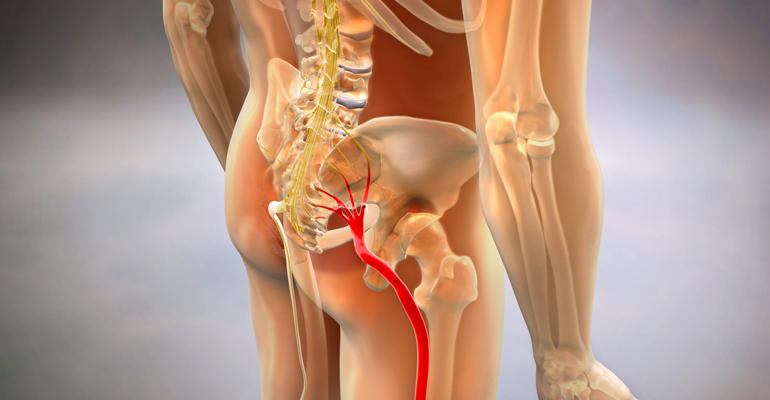-
-
+91-8591556577
-
Sciatica

Sciatica
Sciatica refers to pain that radiates along the path of the sciatic nerve, which extends from the lower back through the hips and buttocks and down each leg. This condition typically affects only one side of the body and can result in significant discomfort and functional limitations.
What Causes Sciatica?
Sciatica is not a condition in itself but a symptom of an underlying issue. Common causes of sciatica include:
- Herniated Discs: A slipped or herniated disc can compress the sciatic nerve, leading to pain, numbness, or weakness.
- Spinal Stenosis: This condition involves narrowing of the spinal canal, which can put pressure on the sciatic nerve.
- Spondylolisthesis: When one vertebra slips over another, it can lead to nerve compression and sciatica.
- Piriformis Syndrome: The piriformis muscle, located in the buttock region, can spasm and irritate the sciatic nerve, causing pain.
- Injury or Trauma: Direct injury to the lower back or pelvic region can lead to inflammation or nerve compression.
Symptoms of Sciatica
The symptoms of sciatica can vary widely, but they commonly include:
- Pain: A sharp, shooting pain that may radiate from the lower back through the buttock and down the leg. This pain can vary in intensity and may worsen with movement.
- Numbness or Tingling: Individuals may experience numbness or a tingling sensation in the affected leg or foot.
- Muscle Weakness: The affected leg may feel weak, making it difficult to stand or walk.
- Pain with Movement: Pain may worsen with certain movements, such as bending, coughing, or sitting for extended periods.
Diagnosing Sciatica
A healthcare provider will typically diagnose sciatica through a physical examination and a review of the patient’s medical history. During the examination, the provider will assess reflexes, strength, and range of motion. Imaging tests, such as X-rays, MRI, or CT scans, may be ordered to identify the underlying cause of the sciatica and rule out other conditions.
Treatment Options for Sciatica
The treatment for sciatica focuses on relieving pain, addressing the underlying cause, and restoring function. Options may include:
Non-Surgical Treatments
- Rest and Activity Modification: Short periods of rest and avoiding activities that exacerbate symptoms can help reduce inflammation and pain.
- Physical Therapy: A physical therapist can develop a tailored exercise program to improve strength, flexibility, and posture, which can alleviate pressure on the sciatic nerve.
- Pain Management: Over-the-counter medications, such as NSAIDs (ibuprofen or naproxen), can help reduce pain and inflammation. In some cases, stronger prescription medications may be necessary.
- Heat and Cold Therapy: Applying heat or cold packs to the affected area can help relieve pain and reduce inflammation.
- Epidural Steroid Injections: In cases of severe pain, corticosteroid injections may be administered to reduce inflammation around the sciatic nerve.
Surgical Treatments
If conservative treatments do not provide relief after several months, surgical options may be considered:
- Discectomy: This procedure involves removing a portion of the herniated disc that is pressing on the sciatic nerve.
- Laminectomy: This procedure removes a small section of the vertebra (the lamina) to relieve pressure on the nerve roots.
- Foraminotomy: This surgery widens the space where the sciatic nerve exits the spinal canal to relieve pressure.
Recovery and Rehabilitation
Recovery from sciatica varies by individual and treatment approach. Non-surgical treatments may lead to gradual improvement over several weeks, while surgical recovery may take longer and often involves physical therapy. Engaging in a rehabilitation program is crucial for restoring function and preventing recurrence.
Preventing Sciatica
While not all cases of sciatica can be prevented, certain measures can help reduce the risk:
- Maintain a Healthy Weight: Keeping weight in check can alleviate pressure on the spine.
- Practice Good Posture: Proper posture while sitting, standing, and lifting can reduce strain on the back and prevent nerve compression.
- Engage in Regular Exercise: Regular physical activity that focuses on strengthening core and back muscles can provide support to the spine.
- Use Proper Lifting Techniques: When lifting heavy objects, bend at the knees and keep the load close to the body to minimize stress on the back.
- Stay Active: Regular movement can help keep the spine flexible and healthy, reducing the risk of injury.
